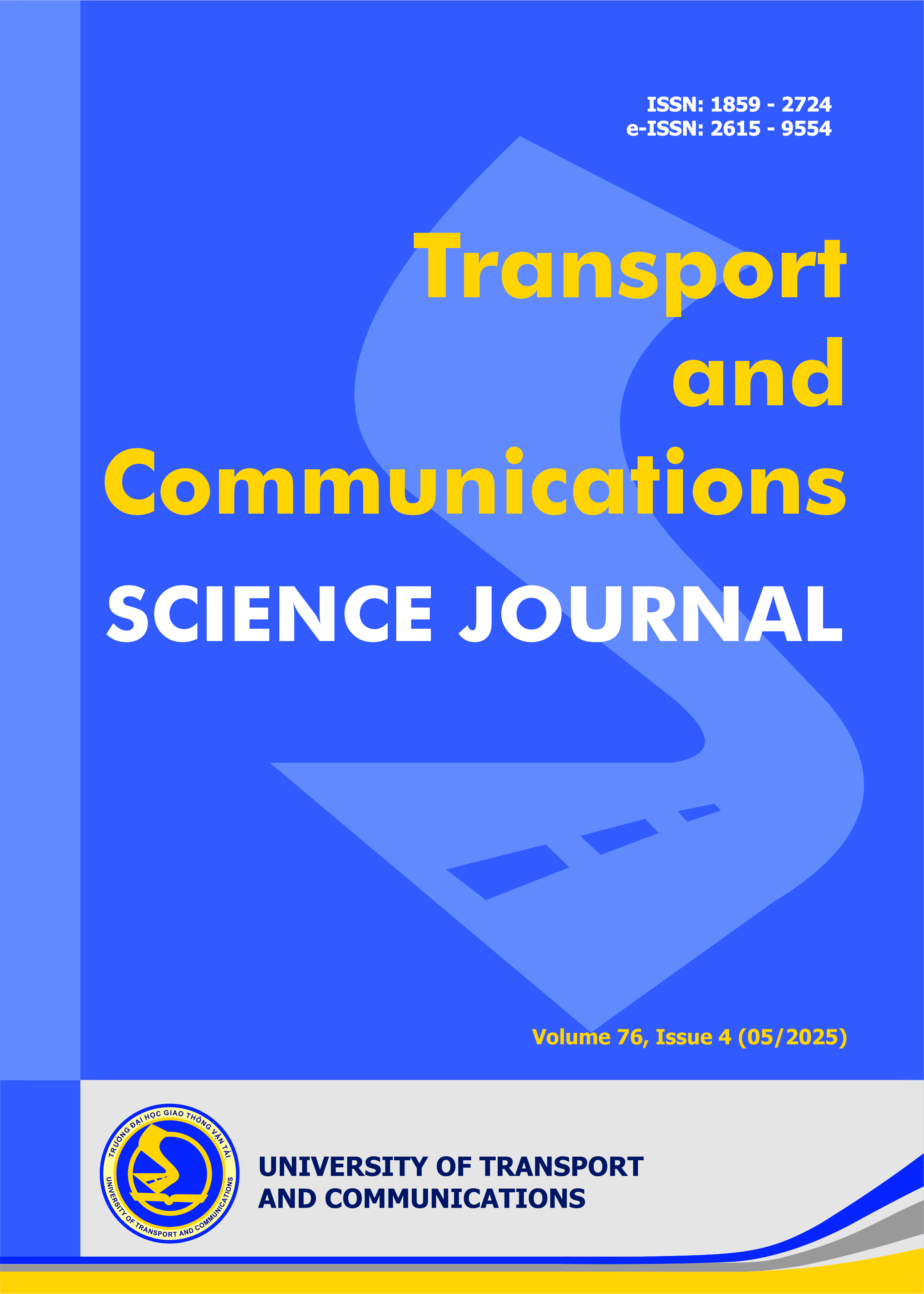2D computational study of the aerodynamics of the S4110 airfoil at low wind speeds using QBLADE and XFLR5
Email:
hungtkm@utc.edu.vn
Từ khóa:
lift coefficient, drag coefficient, Reynolds coefficient, airfoil, CFD method, XFLR5
Tóm tắt
The design of the wind turbine blades has a significant impact on the operation of the wind turbine. Therefore, the cross-sectional structure of the airfoil needs to be simulated by specialized software to evaluate the impact on the performance of the wind turbine, especially in the low wind speed region. This paper studies the aerodynamic characteristics such as lift coefficient (CL), drag coefficient (CD) and ratio (CL/CD) in the attack angle ranges from -8 degrees to 10 degrees of the S4110 airfoil model under low wind velocity (3 m/s) using QBLADE and XFLR5 software with Reynolds coefficient margin conditions of 200000, Mach coefficient of 0.3 and Ncit coefficient of 9. Evaluate the ability to analyze aerodynamic parameters. The purpose of the study is to verify the accuracy of the two software in wind turbine design under low wind velocity by comparing the simulation results with experimental data from Airfoiltool. The results showed that both the QBLADE and XFLR5 achieve high accuracy at small attack angles (from -4.5 degrees to 4 degrees), with an error of less than 5%. Besides, the optimal angle of attack of the model is determined with the value of 4 degrees and a Ratio (CL/CD) value of 80.02Tài liệu tham khảo
[1]. J. F. Manwell, J. G. McGowan, A. L. Rogers, Wind Energy Explained: Theory, Design and Application, (2010). https://doi.org/10.1002/9781119994367
[2]. B. Backwell, Wind power: The struggle for control of a new global industry: 2nd Edition, (2017). https://doi: 10.4324/9781315112534
[3]. M. Alaskari, O. Abdullah, M. H. Majeed, Analysis of Wind Turbine Using QBlade Software, in IOP Conference Series: Materials Science and Engineering, (2019). https://doi:10.1088/1757-899X/518/3/032020
[4]. D. Zahariea, D. E. Husaru, C. M. Husaru, Aerodynamic and structural analysis of a small-scale horizontal axis wind turbine using QBlade, in IOP Conference Series: Materials Science and Engineering, (2019).
[5]. F. Rahman, S. W. Ul Huda, S. T. Sneha, J. Hossain, and M. Haque, Numerical Analysis of Modified NACA 4412 Airfoil for Implementation of Low Reynolds Numbers VAWTs, 51 (2022) 28–38.
[6]. Yash Shah, Juhi Kothari, Mehek Shaikh, Ramesh Rajguru, Study of Performance Ratio of Newly Developed High-Performance Airfoil with Respect to the Airborne Wind Energy System, in Advances in Clean Energy and Sustainability, Springer Nature Singapore, 1 (2024) 347–356. https://doi.org/10.1007/978-981-97-5415-1_29
[7]. R. S. Jegan Vishnu, B. D. Baloni, Numerical Analysis of Buoyant Balloon for Airborne Wind Turbines, in Lecture Notes in Mechanical Engineering, (2023).
[8]. B. A. Dinh, H. K. Ngo, and V. N. Nguyen, An efficient low-speed airfoil design optimization process using multi-fidelity analysis for UAV flying wing, Science and Technology Development Journal, 19 (2016) 43-52.
[9]. Le Quang Sang, Tinnapob Phengpom, Dinh Van Thin, Nguyen Huu Duc, Le Thi Thuy Hang, Cu Thi Thanh Huyen, Nguyen Thi Thu Huong, Tran Thi Quynh, A method to design an efficient airfoil for small wind turbines in low wind speed conditions using XFLR5 and CFD simulations, Energies, 17 (2024).
[10]. D. Van Thin, L. Q. Sang, C. D. Van, D. N. Huu, Modifying NACA6409 Airfoil Configuration to Improve Aerodynamic Performance in Low Wind Speeds, in Conference Proceedings - 2023 IEEE Asia Meeting on Environment and Electrical Engineering, EEE-AM 2023, (2023) 1-5.
[11]. D. Van Thin, N. H. Duc, L. Q. Sang, Aerodynamic Analysis of NACA64A010 Airfoil Using XFLR5 and ANSYS Fluent, GMSARN International Journal, 18 (2024) 258–266, http://gmsarnjournal.com/home/wp-content/uploads/2023/09/vol18no2-13.pdf
[12]. Airfoil plotter (s4110-il) (airfoiltools.com), http://airfoiltools.com/airfoil/details?airfoil=s810-nr.
[13]. D. Marten, QBlade: A Modern Tool for the Aeroelastic Simulation of Wind Turbines vorgelegt von, PHD thesis, TU Berlin, (2020).
[14]. M. Drela, XFOIL: an analysis and design system for low Reynolds number airfoils, Low reynolds number aerodynamics. Proc. Conf., NOTRE DAME, U.S.A., Berlin, Germany, Springer-Verlag, (54) 1989.
[15]. Dinh Van Thin, Nguyen Huu Duc, Le Quang Sang, Aerodynamic analysis of naca 6409 airfoil in wind turbine by using panel method, TNU Journal of Science and Technology, 227 (2022) 227–235, https://doi.org/10.34238/tnu-jst.5591
[16]. T. Chen, C. Wang, T. Liu, On physics of boundary vorticity creation in incompressible viscous flow, Acta Mechanica Sinica/Lixue Xuebao, 40 (2024) 323443.
[17]. W. F. Merzkirch, Mach’s Contribution to the Development of Gas Dynamics, in Ernst Mach: Physicist and Philosopher, Boston Studies in the Philosophy of Science, Springer, Dordrecht, 6 (1970) 42–59.
[18]. M. Ahmad, Z. L. Hussain, S. I. A. Shah, T. A. Shams, Estimation of stability parameters for wide body aircraft using computational techniques, Applied Sciences, 11 (2021) 1-26.
[2]. B. Backwell, Wind power: The struggle for control of a new global industry: 2nd Edition, (2017). https://doi: 10.4324/9781315112534
[3]. M. Alaskari, O. Abdullah, M. H. Majeed, Analysis of Wind Turbine Using QBlade Software, in IOP Conference Series: Materials Science and Engineering, (2019). https://doi:10.1088/1757-899X/518/3/032020
[4]. D. Zahariea, D. E. Husaru, C. M. Husaru, Aerodynamic and structural analysis of a small-scale horizontal axis wind turbine using QBlade, in IOP Conference Series: Materials Science and Engineering, (2019).
[5]. F. Rahman, S. W. Ul Huda, S. T. Sneha, J. Hossain, and M. Haque, Numerical Analysis of Modified NACA 4412 Airfoil for Implementation of Low Reynolds Numbers VAWTs, 51 (2022) 28–38.
[6]. Yash Shah, Juhi Kothari, Mehek Shaikh, Ramesh Rajguru, Study of Performance Ratio of Newly Developed High-Performance Airfoil with Respect to the Airborne Wind Energy System, in Advances in Clean Energy and Sustainability, Springer Nature Singapore, 1 (2024) 347–356. https://doi.org/10.1007/978-981-97-5415-1_29
[7]. R. S. Jegan Vishnu, B. D. Baloni, Numerical Analysis of Buoyant Balloon for Airborne Wind Turbines, in Lecture Notes in Mechanical Engineering, (2023).
[8]. B. A. Dinh, H. K. Ngo, and V. N. Nguyen, An efficient low-speed airfoil design optimization process using multi-fidelity analysis for UAV flying wing, Science and Technology Development Journal, 19 (2016) 43-52.
[9]. Le Quang Sang, Tinnapob Phengpom, Dinh Van Thin, Nguyen Huu Duc, Le Thi Thuy Hang, Cu Thi Thanh Huyen, Nguyen Thi Thu Huong, Tran Thi Quynh, A method to design an efficient airfoil for small wind turbines in low wind speed conditions using XFLR5 and CFD simulations, Energies, 17 (2024).
[10]. D. Van Thin, L. Q. Sang, C. D. Van, D. N. Huu, Modifying NACA6409 Airfoil Configuration to Improve Aerodynamic Performance in Low Wind Speeds, in Conference Proceedings - 2023 IEEE Asia Meeting on Environment and Electrical Engineering, EEE-AM 2023, (2023) 1-5.
[11]. D. Van Thin, N. H. Duc, L. Q. Sang, Aerodynamic Analysis of NACA64A010 Airfoil Using XFLR5 and ANSYS Fluent, GMSARN International Journal, 18 (2024) 258–266, http://gmsarnjournal.com/home/wp-content/uploads/2023/09/vol18no2-13.pdf
[12]. Airfoil plotter (s4110-il) (airfoiltools.com), http://airfoiltools.com/airfoil/details?airfoil=s810-nr.
[13]. D. Marten, QBlade: A Modern Tool for the Aeroelastic Simulation of Wind Turbines vorgelegt von, PHD thesis, TU Berlin, (2020).
[14]. M. Drela, XFOIL: an analysis and design system for low Reynolds number airfoils, Low reynolds number aerodynamics. Proc. Conf., NOTRE DAME, U.S.A., Berlin, Germany, Springer-Verlag, (54) 1989.
[15]. Dinh Van Thin, Nguyen Huu Duc, Le Quang Sang, Aerodynamic analysis of naca 6409 airfoil in wind turbine by using panel method, TNU Journal of Science and Technology, 227 (2022) 227–235, https://doi.org/10.34238/tnu-jst.5591
[16]. T. Chen, C. Wang, T. Liu, On physics of boundary vorticity creation in incompressible viscous flow, Acta Mechanica Sinica/Lixue Xuebao, 40 (2024) 323443.
[17]. W. F. Merzkirch, Mach’s Contribution to the Development of Gas Dynamics, in Ernst Mach: Physicist and Philosopher, Boston Studies in the Philosophy of Science, Springer, Dordrecht, 6 (1970) 42–59.
[18]. M. Ahmad, Z. L. Hussain, S. I. A. Shah, T. A. Shams, Estimation of stability parameters for wide body aircraft using computational techniques, Applied Sciences, 11 (2021) 1-26.
Tải xuống
Chưa có dữ liệu thống kê

Nhận bài
23/02/2025
Nhận bài sửa
08/04/2025
Chấp nhận đăng
10/05/2025
Xuất bản
15/05/2025
Chuyên mục
Công trình khoa học
Kiểu trích dẫn
Bui Van, H., Vu Minh, P., Le Quang, S., Vu Duy, D., & Nguyen Quang, H. (1747242000). 2D computational study of the aerodynamics of the S4110 airfoil at low wind speeds using QBLADE and XFLR5. Tạp Chí Khoa Học Giao Thông Vận Tải, 76(4), 461-473. https://doi.org/10.47869/tcsj.76.4.2
Số lần xem tóm tắt
87
Số lần xem bài báo
72









